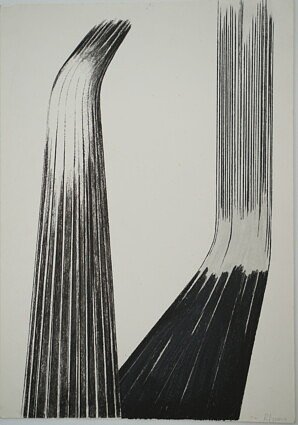Rosanna
Lancia
Biography
Rosanna Lancia was born in 1925 in Rome. She completed her first degree in Classical Studies and graduated from the Academy of Fine Arts in 1946. She began with painting fresco and sacred art. Her first solo painting exhibition was in 1953 at Gaspero del Corso’s L’Obelisco gallery. In 1959 she participated in the VIII Quadriennale in Rome. In 1965 she moved to plastic language with iron sculptures, and in the 1970s she conducted a long term research on the resistance of matter that she synthesized in the well-known audiovisual Tensioni, a hypothesis of language. In 1981 she founded the association Spaziodocumento, a center for meeting and analysis of the languages of contemporary art, from which she published the report in 1994. In the two years that followed, the association’s activities also continued at the Museo Laboratorio of La Sapienza University in Rome under the direction of Maurizio Calvesi. In 1995, she participated in the Venice Biennale. She has participated in numerous solo and group exhibitions in Italy as well as in international shows such as the International Festival of Women Artists in Copenhagen in 1980, and the International Sculpture Biennial in Budapest in 1994 and 1996. From 1998 to 2000, she made environmental proposals for the banks of the Brenta River and for the Museo Comunale in Rome. In 2000 she participated in the group show Contemporary Art: Work in Progress No. 9 at MACRO. In 2011 she held a solo show Rigor Paradisi at the Cortese & Lisanti Gallery in Rome, and in 2014 a double solo show with Nedda Guidi at the Monserrato Arte ‘900 Gallery. In 2021 her works were exhibited at Gramma_Epsilon Gallery in Athens in the exhibition Historie d’E part 2 between language and object, and in 2023 in the exhibition Books as Art.

Critical text
“The sign, the water and the iron. From the artificial to the natural and vice versa. Rosanna Lancia seeks the nature and truth of things along a path made up of mysterious lines: from fresco works to the three-dimensional research of matter, from pigments to iron, which becomes ductile like water. From the 1950s to the 1990s, Rosanna Lancia’s work changed, following the artist’s poetic path, experimentation and curiosity. But the common denominator in her work remains the sign.
Born in 1925 in Rome, the artist has dedicated herself to painting and frescoes since the 1950s. In the mid-1960s she concentrated on graphics and drawing, adopting various media, such as paper and smooth canvas.
From the geometries which she studied in those years, works that she created later were born. After having experimented with two-dimensional painting, Rosanna Lancia gave a turning point to her work in the 1970s. In that period she discovered that she can give three-dimensionality to the works. She was recovering that passion for the material, “an old love” that characterized her since her youth, when she attended the Academy of Fine Arts in Rome which concluded with a thesis on the cycle of frescoes by Fra Angelico, in the Nicolina Chapel in the Vatican. “I started in the classical way, attending the academy, working with fresco, lime and form. And I learned that fresco does not forgive, there can be no ambiguity – explains the artist – I loved this work very much.
Physical moments are experienced on the scaffolding”. Wall, lime and mortar: in one word the material. “The passion for Mario Sironi and for grays led me to cancel the color, then with the black and white drawing the matter prevailed, which served me as a technical study in search of the sign”. The line, like matter, must not be ambiguous. “The sign of Lancia has materialized in a solid material: that is, it has sought a freer and more autonomous expression” writes Sandra Orienti in the presentation of a solo show at the Galleria Numero in Rome (1971). Lorenza Trucchi, also in 1971, affirms that “well, Lancia has moved on to sculpture. A sculpture, however, not of volumes and masses but of structures, of warp: almost a drawing in space”. And to create these “essential arabesques” Lancia uses the quadrello, an iron section with a square plan, the side of which can be of different sizes, from a few millimeters to a few centimeters. The square is usually used in industrial work and has considerable flexibility, ideal for the artist who uses it up to its limit of resistance. The sculptress chose to use the square because “it allows us to interpret the sign in an unequivocal way”. The wrought iron is transformed. The material, like a caterpillar that becomes a butterfly, loses the salient features of heaviness and immobility, to become something else: something alive, light that gives the idea of water. Art is alchemy and allows the elements to undergo substantial transformations in the mind, which takes shape. The artist’s hands forge waves, waves are signs. A search for the line materializes, which from clear and broken state becomes soft and gestural. An example is the pictorial work I met the sea, from 1984. Its last exhibition took place at the Municipal Museum of Contemporary Art in Rome. Considered an innovative artist on the Italian scene, Lancia is known in Italy and abroad. The director of the Cholet Museum (France) commented that he appreciates her for the characteristics of her work on materials, the balance of strength and resistance. Another sign engraved in one’s personal journey.”
_Nadia Grillo










